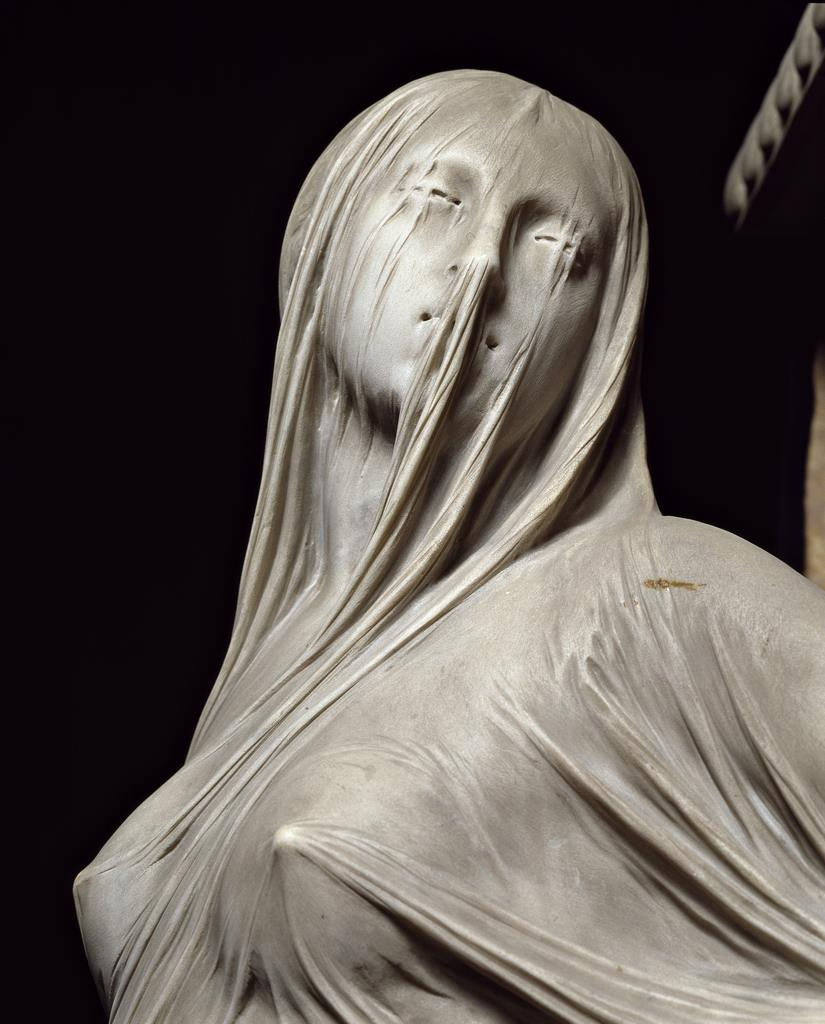"La Pudicizia" (Modesty or Chastity), also known as "Veiled Truth," is a marble sculpture created by the Italian artist Antonio Corradini in 1752 during the Rococo period. The sculpture is housed in the Cappella Sansevero in Naples, a chapel renowned for its rich collection of artworks. Commissioned by Raimondo di Sangro, the seventh Prince of Sansevero, the sculpture serves as a memorial to his mother, Cecilia Gaetani dell'Aquila d'Aragona, who passed away when Raimondo was just an infant. This masterpiece is a testament to Corradini's exceptional skill in depicting the human form beneath a delicate veil of marble, a technique that he perfected over the course of his career.
About the Artist and the Work
Antonio Corradini, born in Venice, was a celebrated sculptor of the 18th century who worked primarily in Venice but also spent significant periods in Vienna and Naples. "Modesty" was the final piece in Corradini's series of veiled female nudes, a subject that fascinated him throughout his life. His ability to create the illusion of translucent fabric draped over a human body is a hallmark of his work, showcasing his mastery over the medium of marble.
"Modesty" is positioned on a pedestal within the Cappella Sansevero, surrounded by other statues created by various artists. While the chapel is filled with breathtaking art, Corradini's "Modesty" stands out for its intricate detail and emotional depth. The statue was commissioned by Raimondo di Sangro as a tribute to his mother, who died prematurely. This personal connection between the patron and the artwork adds a layer of poignancy to the sculpture.
Visual Features
The figure in "Modesty" is depicted in a contrapposto stance, a classical pose that gives the statue a sense of movement and life. Her weight is shifted onto one foot, creating a naturalistic posture that enhances the realism of the piece. The drapery that falls over her body is both heavy and transparent, accentuating her form while maintaining a sense of modesty. The veil, which covers her face and body, symbolizes the delicate balance between exposure and concealment, inviting viewers to reflect on themes of chastity, purity, and truth.
The figure's face is turned away from the viewer, partially obscured by the veil. This gesture, combined with the flowing drapery, evokes a sense of quiet dignity and introspection. The veil, while appearing to be heavy and opaque, is skillfully rendered to suggest translucency, allowing glimpses of the figure's features beneath it. This play of light and shadow on the marble creates an almost ethereal quality, making the figure appear both human and divine.
The Sansevero Chapel and Its Significance
The Sansevero Chapel, where "Modesty" resides, is home to a series of ten statues representing various virtues, all commissioned by Raimondo di Sangro. "Modesty" is one of two sculptures that Corradini completed for the chapel, the other being "Decorum," a depiction of a youthful male figure. These statues, along with the others in the series, are arranged along the walls of the chapel, each contributing to the overall theme of virtue and spirituality.
"Modesty" is often interpreted as a representation of wisdom, drawing a parallel to the ancient veiled statue of the goddess Isis at Sais in Egypt. The veiled figure of Isis was said to symbolize the past, present, and future, an allegory that resonates with the themes of truth and modesty embodied in Corradini's sculpture. The cracked plaque beneath the statue further emphasizes the tragic brevity of life, alluding to the untimely death of Raimondo's mother.
On the pedestal of "Modesty," there is a relief depicting a biblical scene of Christ appearing to Mary Magdalene as a gardener. This reference to Christian iconography highlights the importance of faith in the lives of the di Sangro family, intertwining the spiritual and personal significance of the sculpture.
Corradini’s Legacy and the Veiled Figures
Antonio Corradini's fascination with veiled figures is evident throughout his career. He often chose to depict women, using the veil as a symbol of purity, chastity, and mystery. His early works featured heavily draped figures in a classical style, but as his technique evolved, he began to explore the possibilities of creating the illusion of thin, translucent veils in marble.
One of Corradini's earlier works that foreshadows "Modesty" is the "Vestal Virgin Tuccia," sculpted in Rome in 1743. In this piece, as in "Modesty," Corradini achieved an astonishing level of realism, making the marble appear almost weightless and fluid. These veiled figures became a signature of Corradini's art, cementing his reputation as one of the foremost sculptors of his time.
Patronage and the Rococo Movement
The creation of "Modesty" was made possible through the patronage of Raimondo di Sangro, a man known for his interest in science and the arts. Patronage played a crucial role in the art world of the 18th century, allowing artists like Corradini to realize their creative visions. Raimondo's influence is evident in the cohesive aesthetic of the Sansevero Chapel, which reflects the ornate and decorative style of the Rococo movement.
The Rococo style, characterized by its lightness, elegance, and use of curving, natural forms, is seen throughout the chapel's design. The building is adorned with a painted ceiling, marble tombs, and intricate relief sculptures, all contributing to its richly decorated interior. "Modesty," with its delicate veiling and graceful pose, is a quintessential example of Rococo art, blending sensuality with spiritual themes.
Conclusion
"La Pudicizia" by Antonio Corradini is more than just a memorial; it is a profound exploration of themes such as modesty, purity, and the passage of time. The sculpture stands as a testament to Corradini's skill as a sculptor and his ability to transform marble into something almost ethereal. Through his masterful use of the veil, Corradini invites viewers to look beyond the surface and contemplate the deeper meanings embedded in this remarkable work of art. In the context of the Sansevero Chapel, "Modesty" not only serves as a tribute to a lost mother but also as a symbol of the enduring virtues that transcend time.











